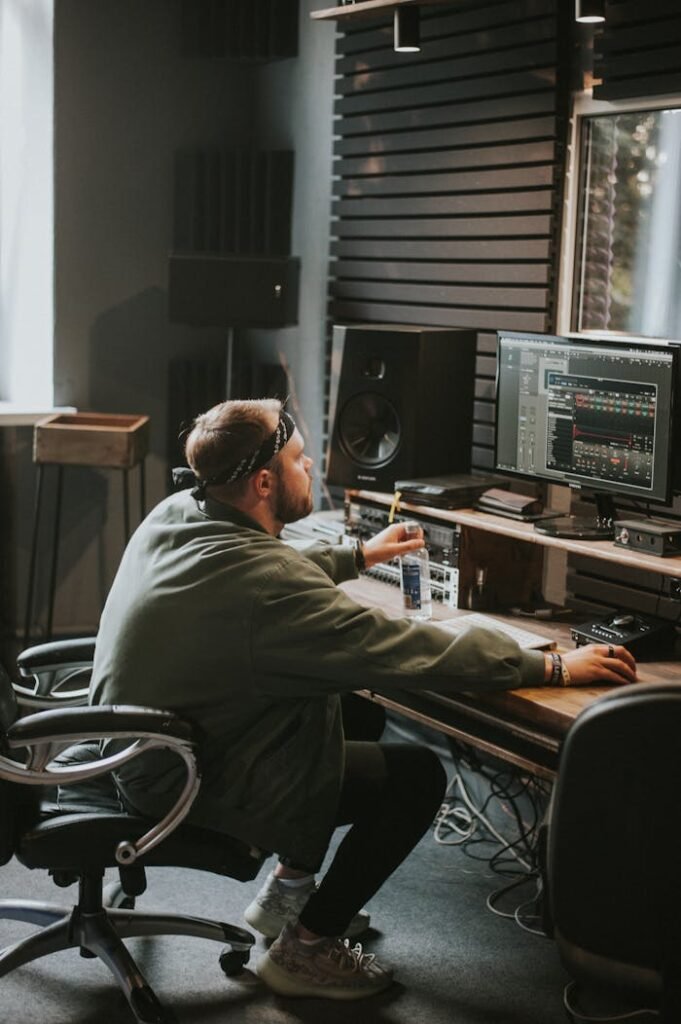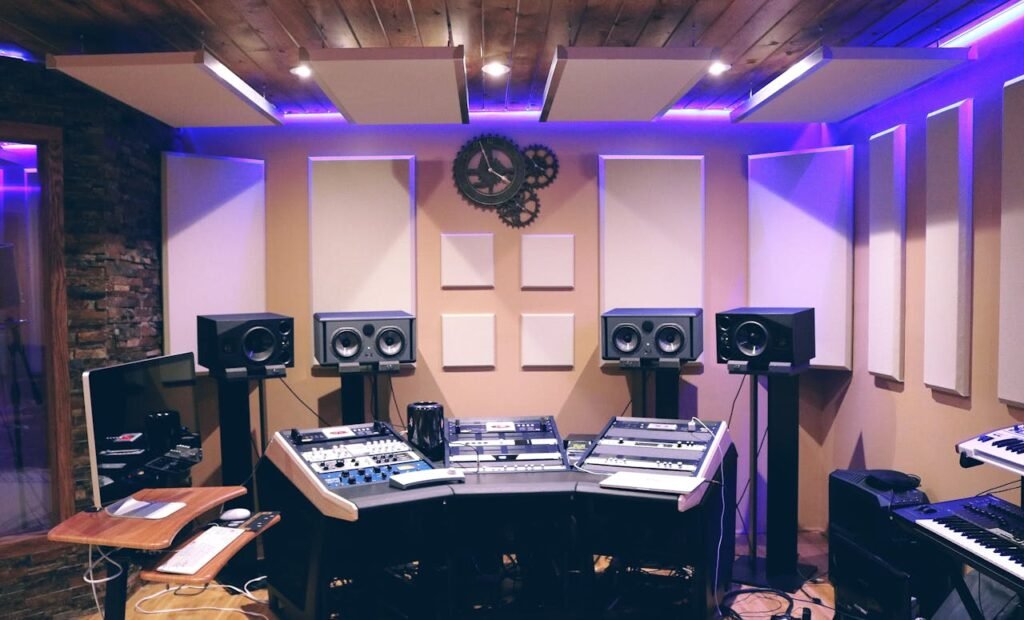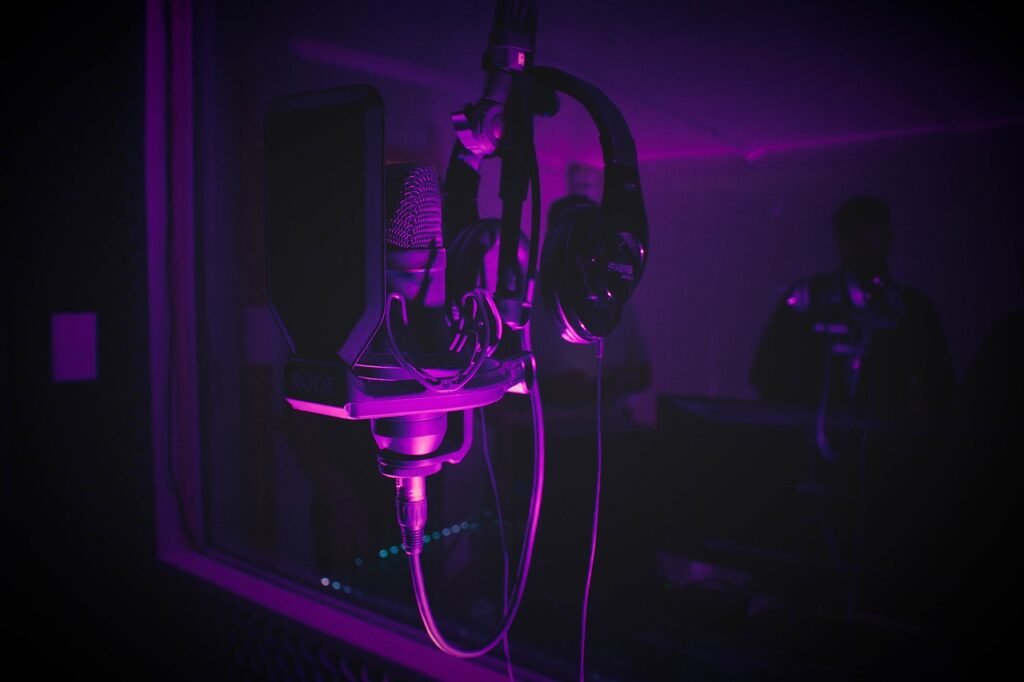If you’re a music producer or an aspiring musician aiming to establish a home studio, it’s essential to equip it with the right studio furniture. This home studio furniture is not just about aesthetics; it’s a key element in creating a professional and comfortable workspace. The right studio furniture enhances both the look and functionality of your space, improving workflow. We’ll guide you through the vital pieces of studio furniture that should be on your checklist as you set up your home recording studio.
Introduction
Creating a home recording studio requires a space that’s both functional and inspiring, fostering creativity and productivity. Studio furniture is pivotal in striking this balance, as it helps organize your equipment, streamline your workflow, and ensures comfort during those extensive music production sessions.
The investment in high-quality studio furniture transcends mere visual appeal; it profoundly influences your experience and the caliber of your recordings. Essential items like studio desks, chairs, racks, and shelves are designed to fulfill specific roles that elevate your studio’s functionality.
We will now examine the essential studio furniture items that are indispensable for every home recording studio, highlighting their features, advantages, and their role in cultivating a more efficient and inspiring work environment.
Studio Desk

A studio desk is the focal point of your home recording studio, serving as a dedicated station for your gear and significantly impacting your workflow’s comfort and efficiency. When selecting studio furniture like a studio desk, you should weigh several factors to make the right choice.
Ergonomics and Comfort
Ergonomics is a top priority when choosing studio furniture such as a studio desk. A desk with an ergonomic design and adjustable height options will enable you to work in comfort, maintaining a healthy posture and minimizing the risk of back and neck strain. This allows you to concentrate on your music production in a pain-free environment.
Size and Layout
The size and configuration of your studio desk should reflect the quantity of equipment you possess and the space constraints of your studio. Make sure the desk you select offers ample surface area to comfortably house your monitors, keyboard, controllers, and any additional gear, with room to spare for potential future upgrades.
Cable Management
An often overlooked aspect of studio desks, including studio furniture rack designs, is cable management. Keeping your cables organized and out of the way not only enhances the aesthetics of your studio but also prevents tangling and damage to your equipment. Desks with built-in cable management solutions, such as cable routing holes or cable trays, are ideal to maintain a clutter-free workspace and ensure cables are neatly organized.
Studio Chair

A comfortable and supportive studio chair is essential for long hours of music production. When selecting studio chairs, consider the following factors:
Comfort and Support
Look for studio chairs that provide ample cushioning and support for your back, neck, and arms. A chair with an ergonomic design is crucial to reduce the risk of musculoskeletal disorders and to enhance overall comfort during extended recording or mixing sessions.
Adjustability
An adjustable studio chair allows you to tailor the height, armrest position, and backrest angle to your preferences and body type. This customization ensures optimal comfort and support, effectively reducing the risk of fatigue and discomfort.
Breathability and Durability
Since music production sessions can be lengthy, it’s important to choose studio chairs with breathable materials that promote air circulation, keeping you cool and comfortable. Additionally, opt for a chair with durable construction that can endure constant use and offer sustained support.
Studio Racks and Shelves

Studio racks and shelves are indispensable for organizing and storing your equipment. They help maximize space utilization and keep your gear easily accessible. Consider the following factors when selecting racks and shelves for your studio:
Equipment Organization
Studio racks and shelves provide a dedicated space for your audio interfaces, preamps, effects processors, and other outboard gear. Organizing your equipment not only streamlines your workflow but also safeguards your gear from accidental damage.
Accessibility and Visibility
Opt for racks that not only enhance your studio’s functionality but also allow easy access to your equipment. Adjustable shelves or sliding racks are ideal for flexibility and convenience when connecting or troubleshooting gear. Moreover, racks with open-back designs or removable panels should be considered for improved visibility and efficient cable management.
Cable Management
Proper cable management is crucial in a recording studio to maintain a clean and organized workspace. Seek out racks that come with integrated cable management solutions, such as cable routing holes or cable clips, to keep your cables neatly organized and minimize the risk of tangling or damage.
Acoustic Treatment

Acoustic treatment plays a vital role in creating a professional and accurate listening environment in your home recording studio. Consider the following aspects when incorporating acoustic treatment:
Sound Reflection and Absorption
Acoustic treatment helps control sound reflections within your studio, reducing unwanted echoes and reverberations. Acoustic panels, bass traps, and diffusers are commonly used to absorb or scatter sound waves, improving the clarity and accuracy of your recordings and mixes.
Diffusion and Bass Traps
Diffusion panels break up sound reflections and create a more balanced sound environment. They help create a natural and spacious feel in your recordings. Bass traps, on the other hand, focus on absorbing low-frequency sound waves, reducing bass buildup and improving overall sound quality.
Placement and Coverage
Strategically placing acoustic treatment panels throughout your studio is crucial for optimal sound control. Consider the dimensions and layout of your room, as well as the specific acoustic issues you want to address, when determining the placement and coverage of your acoustic treatment.
Studio Lighting

Proper lighting is essential for creating a comfortable and inspiring work environment in your home recording studio. Consider the following aspects when setting up studio lighting:
Ambient Lighting
Ambient lighting provides overall illumination in your studio. It sets the mood and creates a welcoming atmosphere. Consider using soft and diffused lighting sources, such as overhead lights or wall-mounted fixtures, to create a balanced and glare-free environment.
Task Lighting
Task lighting focuses on specific areas where detailed work is performed, such as your studio desk or equipment racks. Adjustable desk lamps or LED strip lights can be used to provide targeted illumination, ensuring optimal visibility and reducing eye strain during recording or editing sessions.
Color Temperature
Color temperature refers to the warmth or coolness of the light emitted by a lighting source. Consider using lights with a color temperature of around 5000K, which closely resembles natural daylight. This helps minimize eye fatigue and provides a neutral lighting environment for accurate color perception.
Studio Monitor Stands

Speaker stands, also known as studio monitor stands, play a crucial role in positioning your speakers for optimal sound reproduction and imaging. Consider the following factors when selecting studio monitor stands:
Sound Positioning and Imaging
Speaker stands, or studio monitor stands, help position your speakers at the ideal height and angle for accurate sound imaging and stereo separation. Proper speaker placement ensures that you hear a balanced and detailed representation of your mix, allowing for more precise adjustments and better overall sound quality.
Height and Angle Adjustment
Look for speaker stands with height and angle adjustment capabilities. This allows you to align the speakers with your listening position and ear level, optimizing the sweet spot and minimizing sonic inaccuracies caused by reflections or positioning issues.
Stability and Isolation
Stability is crucial when it comes to speaker stands for studio monitor stands. Look for stands with a solid and sturdy construction to minimize vibrations and ensure that your speakers remain securely in place. Additionally, consider stands with built-in isolation pads or spikes to reduce unwanted vibrations and improve sound clarity.
Keyboard and Controller Stands

In your home recording studio, if you’re using a MIDI keyboard or controller, it’s crucial to have a stable and ergonomic keyboard stand. When selecting keyboard stands, consider factors that contribute to their stability and ergonomic design.
Ergonomics and Reachability
A well-designed keyboard stand not only enhances comfort but also efficiency when playing or programming. Seek out keyboard stands that offer adjustable height and angle options, ensuring a comfortable playing position tailored to your preferences and playing style.
Stability and Adjustability
The stability of keyboard stands is paramount, especially during intense playing or programming sessions. Opt for keyboard stands with a solid construction and consider those with adjustable width options to securely fit various sizes of keyboards or controllers.
Cable Management
Maintaining a clutter-free workspace includes organized cable management. Choose keyboard stands that come equipped with built-in solutions like cable clips or channels, ensuring your cables stay neatly in place and free from tangles or accidental disconnections.
Studio Storage Solutions

Having adequate storage solutions in your home recording studio is essential for equipment protection and organization. Consider the following factors when selecting studio storage solutions:
Equipment Protection and Organization
Investing in storage solutions such as equipment cases, racks, or drawers helps protect your gear from dust, moisture, and accidental damage. Proper equipment organization also saves you time and effort when locating specific items during recording or mixing sessions.
Space Optimization
When space is limited, utilizing storage solutions that maximize vertical space can be highly beneficial. Look for wall-mounted shelves, overhead storage racks, or compact storage units that provide efficient storage options without occupying valuable floor space.
Accessibility and Portability
Consider storage solutions that offer easy accessibility and portability. For example, equipment cases with wheels or handles allow for convenient transportation, while storage racks with slide-out shelves or swivel mechanisms provide easy access to your gear when needed.
Studio Workstation

A studio workstation combines various furniture elements into an integrated design, providing a multifunctional and space-efficient solution for your home recording studio. Consider the following factors when selecting a studio workstation:
Integrated Design
A studio workstation integrates components such as a desk, racks, shelves, and keyboard tray into a cohesive and space-saving design. This ensures that all your essential equipment is within reach, maximizing workflow efficiency and reducing clutter.
Multifunctionality
A well-designed studio workstation offers versatile functionality, accommodating different equipment setups and work styles. Look for workstations with adjustable shelves, modular components, or expandable options to adapt to your evolving needs as a music producer.
Space Efficiency
Space efficiency is crucial, especially in small recording studios. Look for compact and streamlined workstation designs that optimize space utilization without compromising functionality. This allows you to make the most of your available studio space while maintaining a comfortable and productive work environment.
Studio Decor and Personalization

Studio decor and personalization play a significant role in creating an inspiring and motivating work environment. Consider the following aspects when adding decor to your home recording studio:
Inspiration and Creativity
Choose decor elements that inspire and evoke creativity. This can include artwork, posters, or motivational quotes that resonate with your musical aesthetics and goals. Surrounding yourself with visual stimuli that align with your creative vision can enhance your mood and spark new ideas.
Branding and Identity
Consider incorporating elements of your personal brand or musical identity into your studio decor. This can include using your logo or album artwork as wall decor, customizing furniture with personalized touches, or displaying memorabilia that represents your musical journey. Creating a space that reflects your unique brand identity fosters a sense of ownership and pride in your work.
Comfort and Aesthetics
While functionality is essential, don’t forget about aesthetics and comfort. Choose furniture and decor elements that not only enhance your studio’s visual appeal but also contribute to a comfortable and inviting atmosphere. Consider elements such as rugs, curtains, or comfortable seating areas to create a cozy and welcoming ambiance.
Conclusion
Setting up a home recording studio requires careful consideration of both technical and aesthetic factors. Recording studio furniture, including music studio furniture and other furniture for music studio, plays a crucial role in creating a functional, comfortable, and inspiring work environment. From studio desks and chairs to racks, shelves, and storage solutions, each piece of furniture contributes to a well-organized and efficient studio setup.
Remember to prioritize ergonomics, comfort, and functionality when selecting recording studio furniture. Consider your specific needs, available space, and budget to make informed decisions. By investing in quality studio furniture, you can create a professional and enjoyable space that fosters creativity and productivity.
Take the time to research and explore different options, keeping your unique preferences and workflow in mind. With the right recording studio furniture, you can enhance your music production experience and elevate the quality of your recordings and mixes. So, get ready to transform your home recording studio into a well-equipped and inspiring space where your musical ideas can thrive.
This post may contain affiliate links. If you make a purchase through these links, we may earn a small commission at no additional cost to you.








